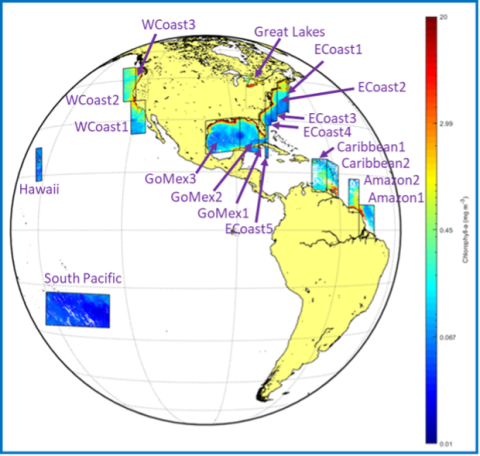DITL of GLIMR
To address GLIMR science goals, the daily operations plan for scanning regions focuses on the Gulf of Mexico. Additional areas of interest (shown in the Figure) are scanned daily, with eastern regions nominally scanned early morning and western regions scanned late in the day.
The GLIMR operations team has useful and adaptive architecture in place to methodically plan operations (e.g., science regions, star-looks, calibrations, LMI targets, etc.). Frequent temporal matchups with PACE orbits can be built into the schedule, for coastal and deep waters.
Novel scheduling based on sunlight availability may help prioritize science objectives throughout the lifetime of the instrument.
A typical DITL scans from Spring to Fall equinox would include the following primary science scans:
- 6x/day Gulf of Mexico (GoMex)
- 3x/day US East Coast
- 3x/day US West Coast
- 2x/day Amazon River Plume AOI
- 2x/day Caribbean Sea ROI
- 3x/day other HAB target sites
- Calibration Sites (MOBY/S. Pacific/PACE)
- Star Looks

The GLIMR PI and science team considers special requests to observe disasters, rapidly evolving features of high science value, and other requests to aid in relevant field campaigns.
Special Request Priorities:
- Disaster and Emergency Acquisitions
- Federally Declared Disasters
- Threshold Violations (e.g., HABs)
- Field Campaigns (NASA, NOAA, EPA)
- Engineering and Calibrations
- U.S. Researcher Requests
- International Researcher Requests